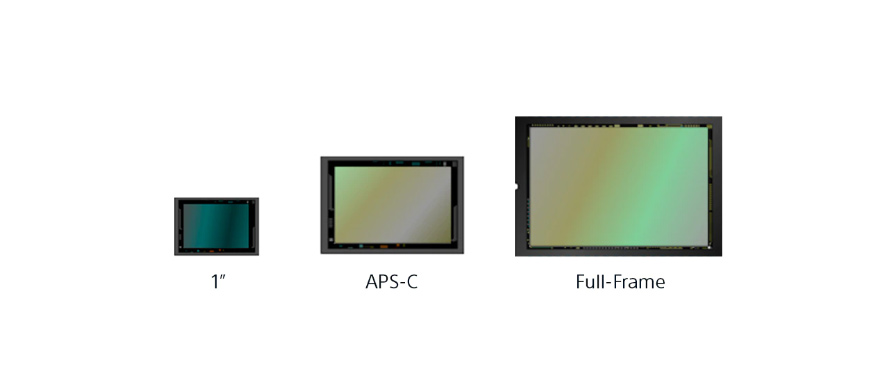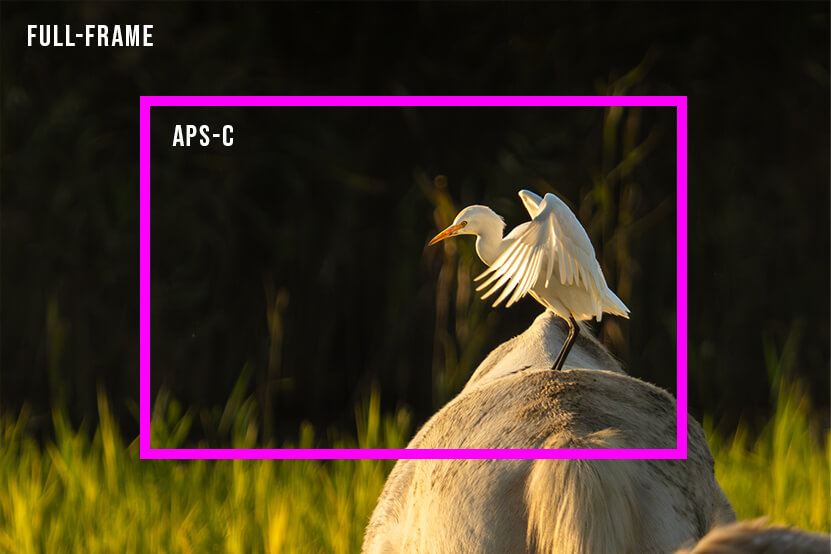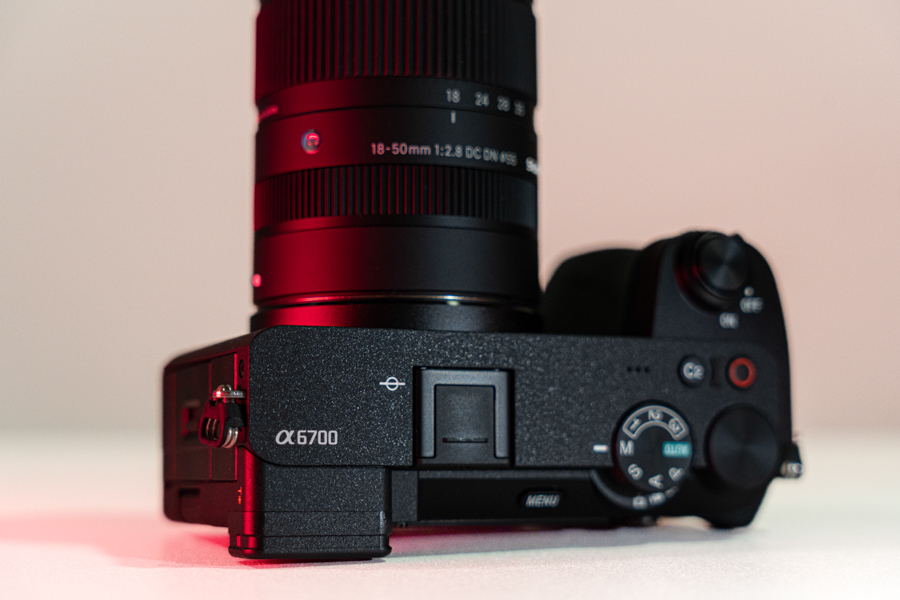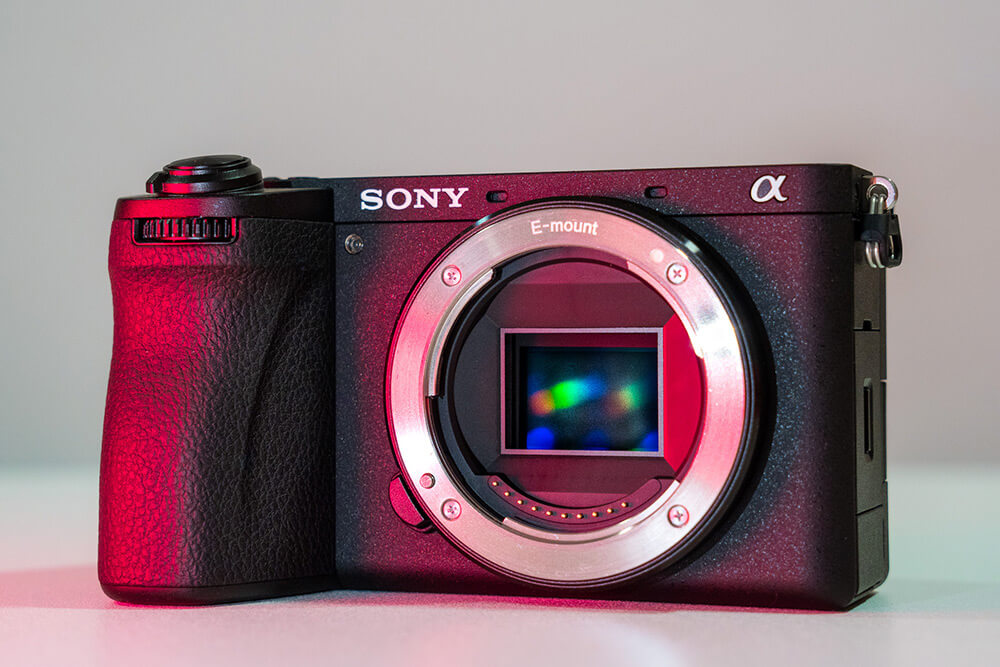Sony uses 2 different sensor sizes in their cameras.
- Full-frame (36x24mm)
- APS-C (23.5×15.6mm)
The APS-C sensor is 1.5x smaller, whereas full-frame is the same size as film back in the day.
Both sensors have their own pros and cons, and in this article I’ll explain the benefits of each system.
What is a Full-Frame Sensor?
Why is it called full-frame?
Because a full-frame sensor measures the same as film (36x24mm). It’s a size everyone was familiar with when digital cameras were first created, so it made sense to continue with it. All lenses and systems were designed around this size.
However, creating full-frame sensors is not cheap, which is why many companies started creating smaller sensors to save on production cost.
What is an APS-C Sensor?
An APS-C sensor is ~1.5x smaller than full-frame.
It results in smaller and cheaper cameras because you need less complex technology to do the same thing as full-frame does.
The latest Sony cameras have in-body stabilization, cooling systems to prevent overheating etc. With smaller cameras, it’s “easier” to implement all this technology without drastically raising the price.
You might be asking yourself; why even bother with full-frame then?

The 3 Biggest Differences Between APS-C and Full-Frame
- Image Quality & Noise
- Crop Factor
- Size & Weight
1. Image Quality & Noise
A sensor, regardless of its size, is made of pixels that convert light into images (the final product we see). If it has 5 million pixels, we call that 5 megapixels.
The goal of every individual pixel is to capture plenty of light, resulting in the highest possible image quality.
- The bigger the pixel, the more accurately it can “read” light.
Because a full-frame sensor is bigger, it means that every individual pixel can be much bigger as well.
Which one do you think has better quality?
- 20 megapixel full-frame sensor
- OR
- 20 megapixel APS-C sensor
The answer? Full-frame.
Same amount of megapixels on both sensors, but full-frame is simply 1.5x bigger, which also means that every pixel is 1.5x bigger as well. Remember, the bigger the pixel, the better the quality.
Does this mean APS-C is bad? Of course not.
It just means that the already excellent APS-C has a competitor that manages to give us even more. Plus, as technology advances, especially compared to ~20 years ago, smaller pixels are getting better and better at working with small amounts of light. Just look at smartphone cameras and how far we have come.
It’s like comparing a $100,000 sports car to another $200,000 sports car. Both are great and more than enough for the majority of people.
Do full-frame cameras have better image quality?
Yes, but it’s not as if you can just instantly tell which sensor was used for which photograph. If you don’t crop/zoom a lot, or didn’t use very high ISO speeds, 99% of people could never tell the difference based on quality alone.
The image below is from Dpreview’s studio quality comparison between the newest Sony A6700 vs A7 IV as well as a much older, full-frame Nikon D750 at ISO 6,400.
The Sony A7 IV (bottom left) has a full-frame sensor and looks a lot better the other 3. In the upper right corner we have the Nikon D750, a full-frame camera released in 2014. It shows a little bit less noise than the Sony A6700 (released in 2023, so almost a 10 year difference), but also less detail.

Credit: Dpreview.com
Related: The Ultimate ISO Guide – 5 Photo Tips for Beginners
These are ISO 6,400 examples, a high ISO that makes any flaws more visible. Under 1,600 it would be much harder to notice differences, let alone at ISO 100. The more into “extreme” you go, the bigger the differences become.
Why do photographs taken at night look bad and noisy?
It’s because there is very little light available and your camera has to raise the ISO speed. This results in more noise being visible on your photographs and the higher you go, the worse it appears.
Full frame cameras show less noise than APS-C cameras.
This is one area where full-frame sensors outperform APS-C by 1 or even 2 stops. For example, a shot taken with the Sony A6700 at ISO 3,200 looks nearly as noisy as Sony A7 IV at ISO 12,800 (that’s a 2 stop difference).
Remember, bigger pixels = better light output. They simply see more, even in darkness.
If you only photograph in low light, it would be ideal to shoot with a full-frame camera. If you use an APS-C, you’ll have to get a lens with a big aperture such as f/2.8 and bigger, or use noise reduction in post process.
Here’s a quick recap:
- Full-frame cameras have bigger pixels, resulting in improved dynamic range and quality
- Full-frame cameras are better for low light due to showing much less noise
2. Crop Factor

Because APS-C sensors are 1.5x smaller, the field of view compared to a full-frame camera appears 1.5x longer.
Confusing?
If you don’t understand what this means, or how it looks like in real life, here’s an example.
- If we mount the Sony 50mm f/1.8 lens on the Sony A7 IV (full-frame), the field of view will look like any 50mm lens.
- If we put that same Sony 50mm f/1.8 on the Sony A6700 (APS-C), we have to multiply the 50mm with 1.5x, so now our 50mm lens looks more like a 75mm on full-frame
Nothing physically changes with your lens, and you also don’t have to do any of these calculations when shooting. Honestly, you don’t even have to worry about this part if it seems too confusing.
When companies name their lenses, they number the focal lengths with full-frame cameras in mind. That’s why we don’t do any calculations for them.
This is simply a useful tip to remember when purchasing a new lens.
Why you should understand the 1.5x crop factor:
Let’s say a professional portrait photographer shooting with a full-frame Sony A9 tells you that they use a 35mm lens because they love the field of view.
You go and buy that same 35mm lens, but put it on your Sony A6600 which is an APS-C model and find out that your images look a bit more “zoomed in” compared to the Sony A9.
That’s because of the 1.5x crop factor.
It’s not great for ultra-wide shots, but it’s amazing for telephoto work.
- APS-C cameras are amazing for wildlife and sports because of their 1.5x crop factor
- You can get 1.5x closer to your subject without buying heaver/bigger lenses

APS-C + 70-350mm (left) versus Full-Frame + 150-600mm (right), different lenses but same field of view
Say you want to shoot wildlife, and read somewhere online that you need a 400mm lens. It’s safe to assume that people always have full-frame in mind when recommending gear unless mentioned otherwise.
You check the price of the Sony 100-400mm f/4.5-5.6 and see it costs around $2500 and weighs 1400g (3.08 lbs.). Expensive and heavy.
However, you remember that your APS-C camera has that 1.5x crop factor. You know that 400mm on full-frame is the same as 266mm on APS-C (400 divided by 1.5).
So now you need to buy a 266mm lens instead of 400mm.
The closest thing to 266mm would be the Sony 70-350mm f/4.5-6.3 which costs around $800 and weighs only 623g (1.37 lbs.). You save a ton of money and weight, but get a similar field of view.
What about ultra-wide lenses?
Sony (and third-party companies) offer plenty of ultra-wide lenses so we’ve got that covered as well, even with the 1.5x crop factor applied.
3. Size & Weight
This is perhaps the biggest advantage of the APS-C system.
- Cheaper cameras & lenses
- Smaller & lighter
To be honest, Sony’s full-frame cameras are already more compact than a lot of competition. I’ve been shooting with the A7 series for a long time and even though they get slightly bigger with every new release, they still feel great to carry around.
However, the APS-C lineup is just that much lighter and easier to travel with. Not only are the cameras smaller, the lenses are waaay more compact. I can pack 2 x f/2.8 zooms in my bag and they take almost as much space as one full-frame f/2.8 zoom.
For traveling, I seriously recommend you to buy an APS-C camera.
Have you ever traveled or brought a ton of photo equipment to a photoshoot only to not use it at all, or perhaps take a few pictures with your phone?
Sometimes having too much gear results in not taking pictures. It’s heavy, it’s big, it doesn’t fit in your jacket or you need to make extra space in your bag. It’s a mix of excuses and tiredness. There are “too many” steps involved and you just don’t bother to take the picture at all.

Related: The 8 Best Lenses for Sony A6700 (APS-C)
The GIF above is a comparison of a complete zoom setup for both APS-C and full-frame.
APS-C Lineup:
- Sony A6700 – 493g (17.39 oz.)
- Sigma 10-18mm f/2.8 – 260g (9.2 oz.)
- Sigma 18-50mm f/2.8 – 290g (10.2 oz.)
- Sony 70-350mm f/4.5-6.3 – 625g (22.1 oz.)
- Total Weight: 1668g (58.8 oz.)
- Price (new): $3,400
Full-Frame Lineup:
- Sony A7 IV – 659g (23.25 oz.)
- Tamron 17-28mm f/2.8 – 420g (14.8 oz.)
- Sigma 28-70mm f/2.8 – 470g (16.6 oz.)
- Tamron 70-180mm f/2.8 – 855g (30.2 oz.)
- Total Weight: 2404g (84.79 oz.)
- Price (new): $5,320
Almost $2,000 cheaper and 1kg lighter with the APS-C setup.
Plus, the telephoto zoom actually goes 170mm longer (but doesn’t have the f/2.8 aperture).
If you’re looking to cover all possible lengths then the APS-C route is much cheaper. I can fit most lenses in my pocket and don’t always have to carry a proper bag with me.
The 10 Most Common Sony Full-Frame vs APS-C Questions

Related: What is Aperture? The Ultimate Guide (+Tips)
1. Is Full-Frame Better than APS-C?
No, they both have their own advantages.
Full-frame sensors have a slightly bigger dynamic range and much better low light performance (low noise levels). Cameras are bigger, heaver and more expensive; same goes for the full-frame lenses.
2. Is APS-C Better than Full-Frame?
What you lose in sensor quality, you gain in size and price department.
APS-C cameras are more travel-friendly and will cost a lot less. Lenses are easily half the weight/price of full-frame competitors with the same field of view.
3. Can you use Full-Frame lenses on APS-C?
Yes, you can use Sony full-frame lenses on APS-C cameras without any issues.
The 1.5x crop factor will still be applied, because it depends on the camera you use. So, a full-frame Sony 50mm f/2.8 can be mounted on APS-C but will have a field of view equivalent to 75mm.
One thing I didn’t mention before is that you the crop factor makes the equivalent aperture 1 stop smaller as well. A 50mm f/2.8 on full-frame will look nearly identical to a 75mm f/2.8 lens on APS-C.
4. Can you use APS-C lenses on Full-Frame?
Yes, you can use Sony APS-C lenses on full-frame cameras.
However, because the lenses are designed for smaller sensors you will see vignetting and perhaps some other optical issues. That’s why many latest full-frame Sony’s will crop 1.5x into the image, thus making it somewhat useless unless you already own APS-C lenses and currently don’t have anything to shoot with.
5. Should you upgrade from Sony APS-C to Full-Frame?
If you have the budget and feel that your current gear is limiting you it would be wise to look at full-frame cameras.
Usually, it’s better to buy a new lens, rather than a new camera. Almost all models for the past few years have incredible photo/video quality, fast auto focus and a ton of features that help us to capture every moment as best as possible.
6. What is APS-C equivalent to Full-Frame?
If you want to calculate the APS-C field of view equivalent to a full-frame camera, simply multiply the focal length by 1.5.
For example:
- Sony 11mm f/1.8 on APS-C is the same as Sony 16.5mm f/1.8 on full-frame.
- Sigma 18-50mm f/2.8 on APS-C is the same as Sony 27-75mm f/2.8 on full-frame
7. Which system is better for traveling?
Sony APS-C cameras are much more ideal for traveling due to their small size and cheaper lenses. They are smaller and fit into any bag, and with an ever growing choice of compact lenses you can travel ultra light.
Sony’s full-frame cameras aren’t huge though, but you have to be more precise when buying lenses if your goal is to travel light.
8. Which system is better for low light?
Sony full-frame cameras are superior to APS-C in low light when it comes to noise performance and dynamic range.
Below ISO 800 you might not see much of a difference, but the real deal starts once you are above ISO 3,200 where many cameras start “falling apart.”
However, with the latest noise reduction programs (Adobe, Topaz etc.) you can actually make your noisy APS-C photographs turn into really clean, low-like ISO looking shots, without losing any detail. It’s really a game changer. This requires a relatively powerful computer and you need to do this manually for each picture.
9. Is APS-C cheaper than Full-Frame?
Sony APS-C cameras are much cheaper than full-frame. You can get an A6000 series camera between $800 and $1,500 new, whereas full-frame cameras don’t go for under $2,000.
Next, you’ll need to buy a couple of lenses. The most common prices for APS-C lenses are somewhere between $300 and $600, for full-frame this is more like $700-$1,500.
10. Are APS-C cameras bad compared to Full-Frame?
No, it is nearly impossible to determine which photograph was taken with APS-C or full-frame, especially if the shot was taken in good conditions (well light scene, sunny day).
Even though full-frame cameras have more dynamic range, unless the photograph was taken at a high ISO, it is very hard to find any differences. Once you account for post-processing etc., it gets even harder, especially if you don’t print images large.


